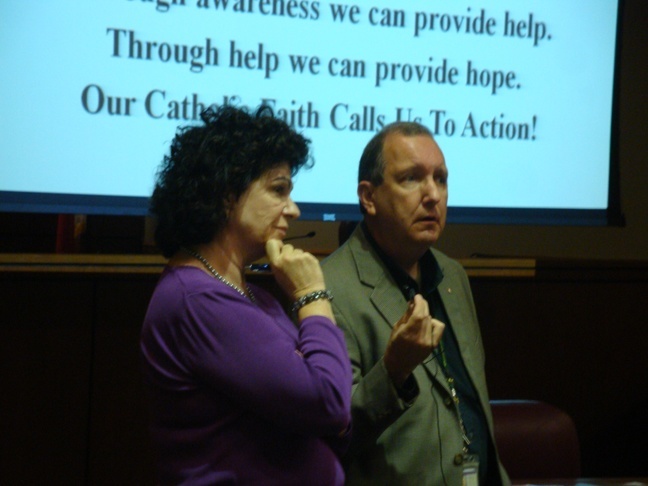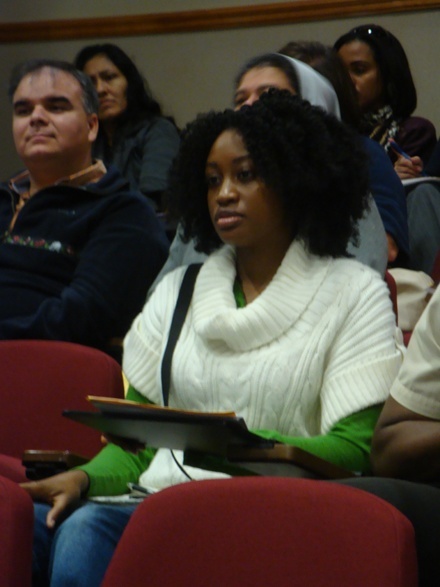By Gail Bulfin - Florida Catholic

Photographer: GAIL BULFIN | FC
Mary Ross Agosta, director of communications for the Archdiocese of Miami, and Tom Gillan, of Catholic Charities of Central Florida, take questions on the roll-out early next year of the parish communication plans for human trafficking awareness.
MIAMI GARDENS � A young girl from Detroit meets a guy by a pay phone. He says he wants to be her boyfriend, wants to take her to Florida so they can go to the Bahamas. He tells her he is a music producer, promises her jewelry. She thinks he likes her. She says yes. They arrive in Fort Lauderdale a few days later.
According to the FBI, he makes her walk the streets. He beats her when she doesn�t bring in enough money. Then he sells her to another pimp who goes by the name �Snake.� She�s 17.
Farm labor contractor Ronald Evans cruises homeless shelters looking for African-American men with substance abuse problems. It is how he staffs his labor pool. He makes them work 15-hour days, packs them into unfit housing, feeds them crack cocaine and alcohol at night then charges them for their room, board and drugs. When convicted, he is sentenced to 30 years.
Authorities notice that many maids at upscale hotels in Florida�s Panhandle are Eastern European. They are recruited in their homeland by Eurohouse Holding Corporation with promises of good-paying jobs. Most are students.
Upon arrival in the U.S., the promised jobs are non-existent. The young travelers are presented with a bill for visa processing, job placement and transportation fees. They are forced to pay off their debt by working in hotels, and sleeping 15-20 people per condo.
The hotels have contracted with Eurohouse to supply labor. According to the federal indictment, the traffickers submitted over 1,000 fraudulent visa applications.
These are just some of the real-life cases discussed at a workshop held Nov. 6 at St. Thomas University School of Law and sponsored by the Archdiocese of Miami. Examples from the report issued by the Center for Human Rights at Florida State University provide the stunning context around which the half-day workshop was designed.
AWARENESS
The workshop is the first step in a process designed to bring awareness to the issues of human trafficking. Parishes were invited to send one or two church-going representatives to the session with the hope that they will serve as a resource for their parish community. Over 125 people representing 67 parishes attended the session.
Albert Harm-Alvares of St. Catherine of Siena Parish in Kendall said, �My pastor tapped me and I was honored. I�ve learned a great deal already.�
In late January or early February, a letter from Archbishop Thomas Wenski will be sent to parishes along with a video, �Invisible Chains,� created specifically for this project. These efforts are the result of collaboration between the U.S. Conference of Catholic Bishops and the Florida bishops targeting three specific audiences: students from grade six to college, Catholic health facilities and Mass-attending Catholics.
Michael McCarron, executive director of the Florida Catholic Conference, said this statewide effort is a step in the right direction. �People are seeing this and saying, yes, I will get more involved.�
Miami�s workshop was the sixth of seven conducted by the three-member team of Tom Gillan of the Office of Criminal Justice for Catholic Charities of Central Florida; Terry Coonan of Florida State University�s Center for the Advancement of Human Rights; and McCarron. The program is designed to serve as a national model for educating communities about the prevalence of human trafficking � and the destruction it causes.
Gillan shared sobering facts about victims of human trafficking. Dozens of hands were raised when he asked the crowd if anyone had ever tried to run away when they were younger.
�Within 24 hours of running away, someone will proposition them,� he said of the dangers today�s young people face. �Florida is a destination for runaways and they are particularly vulnerable to coercion. Someone is offering them love, security and belonging. The runaway thinks the person being nice to them, offering them food or a place to stay really likes them or understands their plight. Unfortunately, it�s a persona the criminal wears in order to coerce the victim.�

Photographer: GAIL BULFIN| FC
Emelyne Museaux, 25, a receptionist from St. Elizabeth of Hungary Parish in Pompano Beach, wondered how wide an audience will see the video on human trafficking which will be sent to all the parishes early next year.
Criminals identify victims online as well as in person. While many are familiar with warnings to watch children�s computer use, Gillan goes a step further. �Get a Facebook account.�
He said parents should go on Facebook to see what their kids are doing. �Kids today are posting everything on Facebook. That�s how we communicate with our kids and how they communicate with each other. And that�s how the predators communicate with our kids. Find out what your children and your grandchildren are doing.�
Coonan warned the crowd to look deeper at places where victims might be hiding in plain sight. �Pimps are recruiting right outside of juvenile hall. They are in the parking lots at Disney.� And at the mall.
While most victims are women, many are men who often don�t see themselves as victims. Coonan said this makes it hard for officials to identify male victims. But he encouraged the audience to recognize that these victims could be �your daughters or your sons.�
Recent hot spots for human trafficking are hotels and resorts, restaurants, nail salons, farms, day labor pools and factories.
Some traffickers even allow their victims to attend church. They are dropped off in front of the church, told to sit in the back in the last pew and to leave church right after Communion. The trafficker usually sits in the van, watches the victims go in and waits for them in the van until they leave.
Coonan said the traffickers then tell their victims, �I let you go to church now you need to do something for me.�
NOT NEW
The church�s commitment to stopping human trafficking is long-standing. In 1965, the Second Vatican Council declared "slavery, prostitution, the selling of women and children, and disgraceful working conditions where people are treated as instruments of gain rather than free and responsible persons" as affronts that poison human society and constitute "a supreme dishonor to the Creator."
Both Pope John Paul II and Pope Benedict XVI have been vocal in their support of efforts to end what Pope John Paul II called a modern plague.
This was not the first conference on human trafficking for the St. Thomas School of Law. It is one of the few law schools offering advanced degrees in Intercultural Human Rights. Roza Pati, a professor of international and human rights law at the school, is one of the key members of the archdiocese�s action team. She has spent much of her adult life working on ways to bring awareness to this international crisis.
She first became aware of the issue while living in Albania, shortly after the fall of the Berlin Wall. People were suddenly free to move across borders. Pati was involved in local politics and her parish priest asked her to visit his home. Upon arrival, he brought her to his backyard where she could see dozens of tiny crosses with names scratched on them. �He told me those were the names of the all the young girls missing from my parish.�
They visited the home of one of the missing girls and it �absolutely broke my heart. She was barely 14 years old,� Pati said.
In 2004, Archbishop Wenski said, �We cannot rest until trafficking in human persons is eliminated from the world.� The workshop, video and educational materials are the tools. He is counting on the Catholic community to rally behind the cause.
FIND OUT MORE
For more information on human trafficking and what the Catholic Church is doing about it, go to:
� www.usccb.org/prolife
� www.cahr.fsu.edu
� www.sharedhope.org
� If you suspect trafficking, call 888-373-7888.
� For information about what the Archdiocese of Miami is doing to combat human trafficking and train parish volunteers, call Mary Ross Agosta, 305-762-1043.
� See related articles here.

